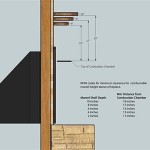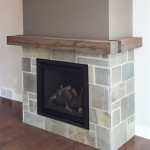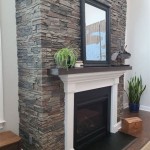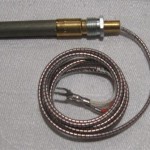Limestone Tile Fireplace Surround: Elegance and Functionality
A fireplace serves as a focal point in many homes, offering warmth and aesthetic appeal. Selecting the appropriate material for a fireplace surround is crucial for both functionality and visual impact. Limestone tile, known for its natural beauty, durability, and versatility, has emerged as a popular choice for fireplace surrounds. This article delves into the characteristics, advantages, installation considerations, and maintenance requirements of limestone tile fireplace surrounds.
Limestone is a sedimentary rock composed primarily of calcium carbonate. It forms over millions of years through the accumulation of marine organisms and their skeletal remains. This process results in a unique texture and appearance, varying significantly depending on the specific geological conditions under which it was formed. The variations in color, veining, and fossil inclusions contribute to the inherent charm and individuality of each limestone tile.
Limestone tiles are extracted from quarries and processed into various sizes and shapes suitable for different design applications. The tiles undergo different finishing techniques, such as honing, polishing, tumbling, and sandblasting, to achieve the desired texture and aesthetic. The selection of the appropriate finish influences the slip resistance, maintenance requirements, and overall visual appeal of the limestone tile fireplace surround.
Key Characteristics of Limestone Tile
Understanding the fundamental characteristics of limestone is essential for making an informed decision regarding its suitability for a fireplace surround. The porosity, density, and thermal resistance of limestone are key factors to consider.
Porosity: Limestone is inherently porous, meaning it contains small voids and spaces within its structure. The degree of porosity affects the material's ability to absorb liquids and resist staining. Higher porosity requires more diligent sealing and maintenance to prevent discoloration and damage from spills. Conversely, lower porosity limestone varieties offer greater resistance to staining and require less intensive maintenance.
Density: The density of limestone affects its durability and resistance to wear and tear. Denser limestone is generally more resistant to scratching, chipping, and cracking, making it suitable for high-traffic areas and applications where impact is a concern. Less dense limestone may be more susceptible to damage and require careful handling during installation and use.
Thermal Resistance: Limestone possesses good thermal resistance, meaning it can withstand temperature fluctuations without significant expansion or contraction. This property is crucial for fireplace surrounds, which are exposed to heat from the firebox. However, it is important to note that extreme temperature changes can still cause stress on the limestone, potentially leading to cracking or discoloration over time. Proper installation techniques and the use of appropriate adhesives and grouts are essential for mitigating these risks.
Advantages of Choosing Limestone for a Fireplace Surround
Limestone offers several advantages as a material for fireplace surrounds, including its aesthetic appeal, durability, versatility, and environmental friendliness.
Aesthetic Appeal: The natural beauty of limestone is a major draw for homeowners seeking a sophisticated and elegant fireplace surround. The subtle color variations, inherent veining, and fossil inclusions create a unique and timeless aesthetic that complements a wide range of interior design styles. Limestone's neutral tones provide a versatile backdrop for various color schemes and decorative elements.
Durability: Limestone is a durable material that can withstand the rigors of daily use. When properly sealed and maintained, a limestone fireplace surround can last for many years without significant deterioration. Its resistance to heat, scratching, and chipping makes it a practical choice for a high-traffic area like a fireplace surround. Proper installation and regular cleaning are essential for preserving the durability and appearance of the limestone.
Versatility: Limestone is a versatile material that can be used in a variety of design applications. It can be cut and shaped into various sizes and shapes, allowing for customized fireplace surround designs. Limestone can also be paired with other materials, such as wood, metal, and glass, to create a unique and visually appealing fireplace feature. The versatility of limestone allows homeowners to tailor the fireplace surround to their specific aesthetic preferences and functional needs.
Environmental Friendliness: Limestone is a natural and sustainable material. It is extracted from quarries and requires minimal processing compared to synthetic materials. The use of limestone in construction can contribute to a more sustainable built environment. Sourcing limestone from reputable suppliers who adhere to environmentally responsible quarrying practices is recommended to minimize the environmental impact.
Installation and Maintenance Considerations
Proper installation and maintenance are essential for ensuring the longevity and beauty of a limestone tile fireplace surround. The selection of appropriate adhesives, grouts, and sealants is crucial for a successful installation. Regular cleaning and sealing are necessary for preserving the appearance and preventing staining.
Installation: The installation of a limestone tile fireplace surround should be performed by experienced professionals who are familiar with the material's characteristics and requirements. Proper surface preparation, including cleaning and leveling the substrate, is essential for ensuring a secure and long-lasting bond. The use of appropriate adhesives specifically designed for natural stone is crucial for preventing discoloration and ensuring proper adhesion. The layout and spacing of the tiles should be carefully planned to achieve the desired aesthetic and minimize waste. Grouting the tiles with a high-quality grout designed for natural stone is essential for preventing water penetration and staining. The grout should be properly sealed to protect it from discoloration and damage.
Sealing: Sealing limestone tiles is crucial for protecting them from staining and water damage. The type of sealant used should be appropriate for the specific type of limestone and the intended application. Penetrating sealants are generally recommended for limestone, as they penetrate the pores of the stone and provide long-lasting protection without altering the appearance of the surface. The sealant should be applied according to the manufacturer's instructions, and the application should be repeated periodically as needed. Regular sealing helps to maintain the beauty and durability of the limestone tile fireplace surround.
Cleaning: Regular cleaning is essential for maintaining the appearance of a limestone tile fireplace surround. Use a mild, neutral pH cleaner specifically designed for natural stone. Avoid using harsh chemicals, abrasive cleaners, or acidic solutions, as these can damage the surface of the limestone. Wipe up spills immediately to prevent staining. Regular dusting and vacuuming can help to remove dirt and debris that can scratch the surface of the limestone. A soft cloth or mop should be used for cleaning to avoid damaging the surface of the stone. Proper cleaning practices help to preserve the beauty and longevity of the limestone tile fireplace surround.
In summary, limestone tile offers a sophisticated and durable option for fireplace surrounds. Understanding its properties, advantages, and required maintenance ensures a beautiful and long-lasting addition to any home.

Houzz Fireplace Ideas Limestone Tile Contemporary Home Brick Makeover

Limestone Fireplace Design Ideas

Limestone Feature Wall With Grey Tiles Contemporary Fireplace Home Design

Why Choose A Limestone Fireplace Stamford Stone At Home

Cast Limestone Fireplace Surround

Limestone Fireplace Design Ideas

Limestone Tile Fireplace Surround Google Search Home Design Remodel

Cast Limestone Fireplace Surround

Gray Limestone Fireplace Mantel With Gold Herringbone Firebox Tiles Transitional Living Room

Sierra Falls Ledge Cut With Limestone Hearth Fireplace Stone Patio








